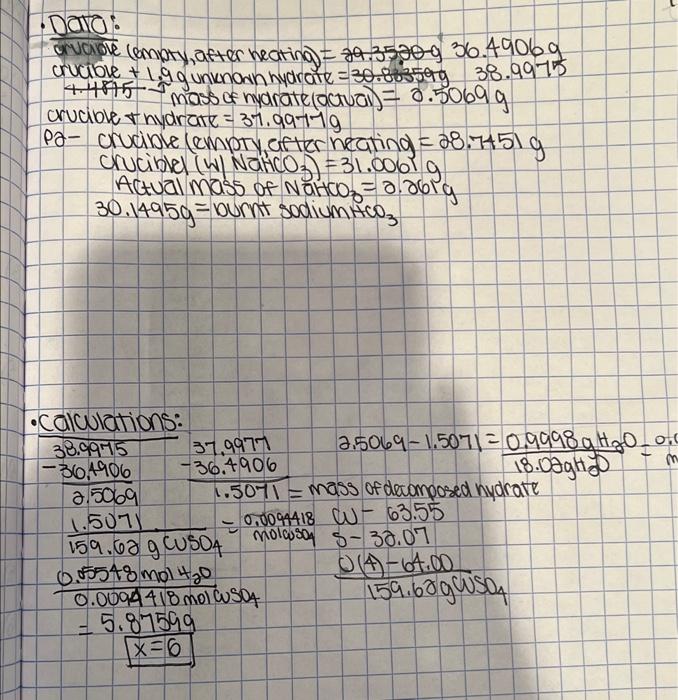1. Using your data from Part I, write the complete chemical formula of the metal sulfate hydrate. Support your conclusion with references to your data. Include the chemical equation that describes the thermal decomposition of the hydrate. Explain any contradictory or inconclusive data and suggest a way to overcome these errors. 2. Using your data from Part II, identify the reaction products and write the complete, balanced chemical equation for the thermal decomposition of sodium hydrogen carbonate. Support your conclusions with references to your data. Include the chemical equations that describe the reactions that occurred in step 7 or write "NR" if no evidence of reaction was observed. Calculate the molecular weight of the solid decomposition product and compare it with the molecular weight of the compound you report as the sodium-containing substance. Explain any contradictory or inconclusive data and suggest a way to overcome these errors. Note: The oxidation state of sodium does not change in the reaction. 3. "In a chemical reaction, atoms are rearranged to form different molecules. No atoms are created or destroyed." You used this basic idea to identify the two unknown products in the thermal decomposition of sodium hydrogen carbonate. This postulate is part of an important theory named for a famous teacher. What is the name of the theory, and who is it named for? 4. Some hydrates spontaneously lose some or all of their waters of hydration when exposed to dry air. These hydrates are called efflorescent. Assume that the metal sulfate hydrate in Part I is efflorescent. How would this affect the value of x ? Would the value of x increase, decrease, or remain unaffected? 5. Assume that the metal sulfate hydrate in Part I is hygroscopic. How would this affect the value of x ? Would the value of x increase, decrease, or remain unaffected? - data: rrualile (empty, after neating =39.3530g36.4906g crucible +1.9g unknown hydrate =30.8.8559938.9975 4.4875. Mass of hy hatate (actuai) =0.5069g crucible thydrate =37.9977g pa- crucible (empty efter neating =28.7451g cruciblel (W) NatiCO3)=31.006gg Actual mass of NaAtCO3=0.26l 30.1495g= burnt sodium ico3 - Calculations: 38.997537.99772.50691.5071=0.9998gH20=0 1. Using your data from Part I, write the complete chemical formula of the metal sulfate hydrate. Support your conclusion with references to your data. Include the chemical equation that describes the thermal decomposition of the hydrate. Explain any contradictory or inconclusive data and suggest a way to overcome these errors. 2. Using your data from Part II, identify the reaction products and write the complete, balanced chemical equation for the thermal decomposition of sodium hydrogen carbonate. Support your conclusions with references to your data. Include the chemical equations that describe the reactions that occurred in step 7 or write "NR" if no evidence of reaction was observed. Calculate the molecular weight of the solid decomposition product and compare it with the molecular weight of the compound you report as the sodium-containing substance. Explain any contradictory or inconclusive data and suggest a way to overcome these errors. Note: The oxidation state of sodium does not change in the reaction. 3. "In a chemical reaction, atoms are rearranged to form different molecules. No atoms are created or destroyed." You used this basic idea to identify the two unknown products in the thermal decomposition of sodium hydrogen carbonate. This postulate is part of an important theory named for a famous teacher. What is the name of the theory, and who is it named for? 4. Some hydrates spontaneously lose some or all of their waters of hydration when exposed to dry air. These hydrates are called efflorescent. Assume that the metal sulfate hydrate in Part I is efflorescent. How would this affect the value of x ? Would the value of x increase, decrease, or remain unaffected? 5. Assume that the metal sulfate hydrate in Part I is hygroscopic. How would this affect the value of x ? Would the value of x increase, decrease, or remain unaffected? - data: rrualile (empty, after neating =39.3530g36.4906g crucible +1.9g unknown hydrate =30.8.8559938.9975 4.4875. Mass of hy hatate (actuai) =0.5069g crucible thydrate =37.9977g pa- crucible (empty efter neating =28.7451g cruciblel (W) NatiCO3)=31.006gg Actual mass of NaAtCO3=0.26l 30.1495g= burnt sodium ico3 - Calculations: 38.997537.99772.50691.5071=0.9998gH20=0








